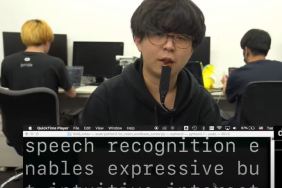Photo: The artist with his work “imprint”.
Anatol Knotek says a lot with a minimal amount of letters. For the Austrian visual artist, it may only take one word, with letters missing, to convey a controversial statement, a heartbreaking sentiment, or a sly punchline.
In one piece, an M and a Y quite literally hang by threads on a wall while fallen F, A, I, and L lie limp on the floor. In another, a finger slashes through stitches once holding together red, all-caps text that reads “memories.” In yet another, “abracadabra” loses a letter with each descending line until there is only an A and a bra beside it.

Artwork: “a bra” by Anatol Knotek.
It was a Viennese poet who turned Knotek onto visual poetry, and encouraged Knotek to visit Open Book, an exhibition in Hünfeld, a city transformed through 100 concrete poems on house facades. A Basquiat quote, “I cross out words so you will see them more; the fact that they are obscured makes you want to read them,” also lit his creative fire for text art.
“It is their beauty but also potential ‘dangerousness,’” he says about the appeal of words. “I love how some letters and words look—there are so many secrets hidden!” The ambiguity of words, their ease of attainability, and their cost-effectiveness as an art-making “material” have also factored into his fascination with language.
Also: Books | Robert Mapplethorpe: The Photographs
Most of what Knotek publishes online, be it on Instagram or his visual poetry-themed Tumblr, is in English, though he also works in German. In both tongues, puns and parallels abound. “I began to use English,” he explains, “not because I can speak it perfectly, but because it is understood by most people. Before I made text art, I was a painter, and the question of understanding was not a matter of language.”
Artistry runs in the family; Knotek’s father is a sculptor. During museum or gallery visits in his youth, he argued often with his old man about which was better: painting or sculpture. “I, of course, thought the painting is the much better art,” he says. “He argued that only sculpture can be seen from different angles. You can walk around, touch it. In German there is the wonderful word ‘begreifen’, which means to touch and to comprehend at the same time.”

Artwork: “memories” by Anatol Knotek.
It could be said that Knotek touches his audience in a different way. Though they seem simple at first glance, his work contains complex layers of meaning and profound emotion. His text portraits of subjects from van Gogh to an unnamed woman, are almost life-like in their detail. An acrylic and permanent marker piece called “the scream” displays a gaping wrist wound gushing blood. Newspaper collages—perhaps the visually “busiest” pieces of his work—reveal lovers’ intertwined bodies. For artwork made of words, the effect is not only mentally stimulating but visceral and sensual as well.
Knotek sees themes of “rising and falling, coming and going, birth and death and different points of view” in his work. These contrasts are also visible in the method of producing the text itself: sometimes through a typewriter, other times through a computer. “I learned that the typewriter helped me a lot in the process of concentrating and minimizing,” he says. “I like the whole process of typing and seeing the real output instantly. It’s so simple and direct. The strength of the keystroke is immediately visible, and so are mistakes.”
Though he didn’t buy his first computer until age 24, he caught up quickly, studying computer science and eventually using Flash Player to create sketches, screenplays, and animated GIFs, which are viewable on his website.
Knotek’s creative process begins when he finds a word or sentence that has “potential.” He then makes a sketch in a book or on the computer, drafting several variations. The most important part—leaving it alone—comes next. Months or even years may pass before he revisits the idea, rethinks it, and whittles it down to the minimal form that has become his trademark.

Artwork: “family” by Anatol Knotek.
Words aren’t Knotek’s only muse—though good luck getting any details on the person who inspires him. When asked who the ‘her’ is in 2 4get her, his handmade book of typewriter poems, he replies, “I’d like to wriggle myself out of this question by just telling you that this book is a rather conceptual piece and I have chosen the title because I see ‘to get her,’ ‘together,’ and ‘to forget her’ in it, which is a drama in itself…and of course there is also a her, but there always is.”





